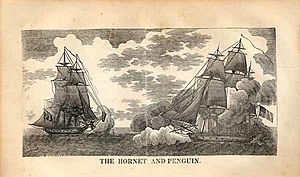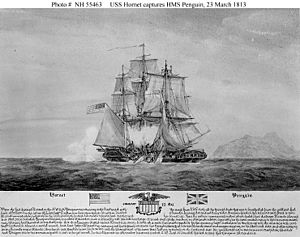Capture of HMS Penguin facts for kids
Quick facts for kids Capture of HMS Penguin |
|||||||
|---|---|---|---|---|---|---|---|
| Part of War of 1812 | |||||||
 The action between USS Hornet and HMS Penguin |
|||||||
|
|||||||
| Belligerents | |||||||
| Commanders and leaders | |||||||
| James Biddle + | James Dickenson † James McDonald (POW) |
||||||
| Strength | |||||||
| 1 warship 20 guns 142 crew |
1 warship 19 guns 132 crew |
||||||
| Casualties and losses | |||||||
| 1 killed 8 wounded, 1 mortally |
14 killed 28 wounded 90 prisoners 1 warship captured |
||||||
On March 23, 1815, a short but fierce sea battle happened off Tristan da Cunha, an island far out in the Atlantic Ocean. The American ship USS Hornet captured the British ship HMS Penguin. This fight was one of the very last battles of the War of 1812, even though the war had officially ended. The American sailors were much better at shooting their cannons, even though both ships were quite similar in size and power. After a lot of cannon fire and musket shots, the British captain was killed. The British ship tried to ram the American ship, but they separated. Penguin was badly damaged and couldn't move, forcing the British to give up. The American sailors then burned the Penguin because it was too damaged to keep.
Contents
Why the Ships Were There
Late in 1814, the United States Navy was getting a small group of ships ready in New York City. Their plan was to sail to the Indian Ocean to attack British trading ships. This group included the large ship USS President, and two smaller ships, USS Peacock and USS Hornet.
The President's Capture
On January 15, the President tried to leave the harbor during a strong storm. It hit the bottom of the harbor entrance, which damaged it and slowed it down. Because of the storm, the President couldn't turn back. It was chased by four British ships that were blocking the harbor. The President was eventually captured by the British.
The Other Ships Continue
The commanders of the other American ships didn't know what had happened to the President. On January 22, another storm blew up. They sailed out in broad daylight, using the storm to their advantage. They were very fast and good at sailing in bad weather, so they managed to get past the British ships blocking the harbor.
They were all supposed to meet up near Tristan da Cunha. This island was a secret meeting spot for American ships. During their journey, the Hornet got separated from the other two ships. The Peacock and a smaller ship called Tom Bowline reached the island first on March 18. But then another storm hit and drove them away. The Hornet arrived at the island on March 22.
The Battle Begins
Captain James Biddle, who commanded the Hornet, was just about to drop anchor. Then, he saw another ship in the distance. Biddle immediately sailed towards it. This other ship was the British Cruizer-class brig-sloop HMS Penguin, commanded by Captain James Dickenson.
Matching Ships
The Penguin was a new ship, having sailed for the first time in September 1814. It had almost the same number of cannons as the Hornet. Both ships carried powerful carronades, which were short-range cannons, and a few longer-range guns. The Penguin had been sent from Cape Town to hunt for an American privateer (a privately owned warship) that was attacking British trading ships.
First Shots
As soon as Captain Dickenson on the Penguin saw the Hornet, he steered his ship towards it and got ready to fight. The Penguin had the advantage of being able to choose how to approach the battle. For a while, the Hornet sailed away from the Penguin, turning sometimes to avoid being hit from the front or back.
Then, both ships turned at almost the same time. They started firing their cannons at each other. This exchange of broadsides (all the cannons on one side of the ship firing at once) lasted for about 15 minutes. The ships slowly got closer to each other, until they were within "musket shot" range.
Close Combat
Captain Dickenson turned his ship to get even closer to the Hornet. He wanted to try and board the American ship and capture it. But he was badly wounded and died. The front part of the Penguin (its bowsprit) crashed across the Hornet's deck, damaging the American ship's ropes and sails.
The British crew on the Penguin didn't try to board the Hornet. The Hornet's crew got ready to board the Penguin, but Captain Biddle stopped them. He wanted to keep fighting with cannons. Biddle thought the British had given up and was about to step onto the Penguin when he was hit by musket balls.
The Penguin's Surrender
As the two ships pulled apart, the Penguin's front mast fell down, breaking off its bowsprit. The British ship had already been hit many times by American cannon fire. With its mast down, the Penguin couldn't move. Lieutenant McDonald, who was now in charge of the Penguin, surrendered.
The British had lost 14 men killed and 28 wounded. Their ship was "riddled through" with holes, and most of the cannons on its right side had been knocked off their mounts. The Americans, however, had only lost one man killed, one who later died from his wounds, and seven wounded. Most of their injuries were from musket fire. The Penguin had taken on 12 extra British Royal Marines, which explains the musket fire. Amazingly, not a single British cannonball had hit the main body of the Hornet.
After the Battle
The Penguin was too badly damaged to be fixed and used again. So, the Americans decided to destroy it after taking off all the useful supplies. They then saw another ship in the distance and quickly set the Penguin on fire. But it turned out the other ships were the Peacock and Tom Bowline, the American ships Hornet had been separated from!
Prisoners and Reunion
The Tom Bowline was sent to a neutral port (Rio de Janeiro, which was then part of the Portuguese Empire). It carried the Penguin's crew, who were taken ashore by American Marines. These British sailors were the last British soldiers and sailors to be taken prisoner during the War of 1812.
The two American ships, Hornet and Peacock, waited for the President until April 15, but it never arrived. Then, they headed for the East Indies, as they had planned originally.
A Close Escape
On April 27, they saw a large ship. At first, they thought it was a British trading ship and eagerly sailed towards it. But then they realized their target was a large British warship, HMS Cornwallis. The American ships split up. The Peacock was faster and quickly disappeared from sight.
The Cornwallis was a new ship, built in Bombay from strong teak wood. It turned out to be very fast and good at sailing. The Hornet only escaped after being chased for two and a half days! To get away, Captain Biddle had to throw overboard many things to make his ship lighter. He got rid of supplies, heavy weights, anchors, cables, cannons, small guns, the capstan (a machine for pulling ropes), the armor maker's anvil, the ship's bell, and even parts of the front deck!
Since the Hornet no longer had any fighting power, Captain Biddle had to sail home. He reached the Cape of Good Hope on May 9. There, he learned that the American government had officially agreed to the Treaty of Ghent on February 18. This meant the war had ended more than a month before the battle with the Penguin!


